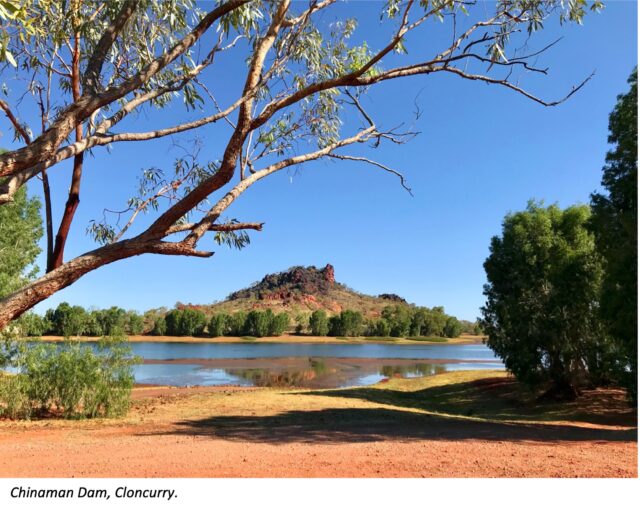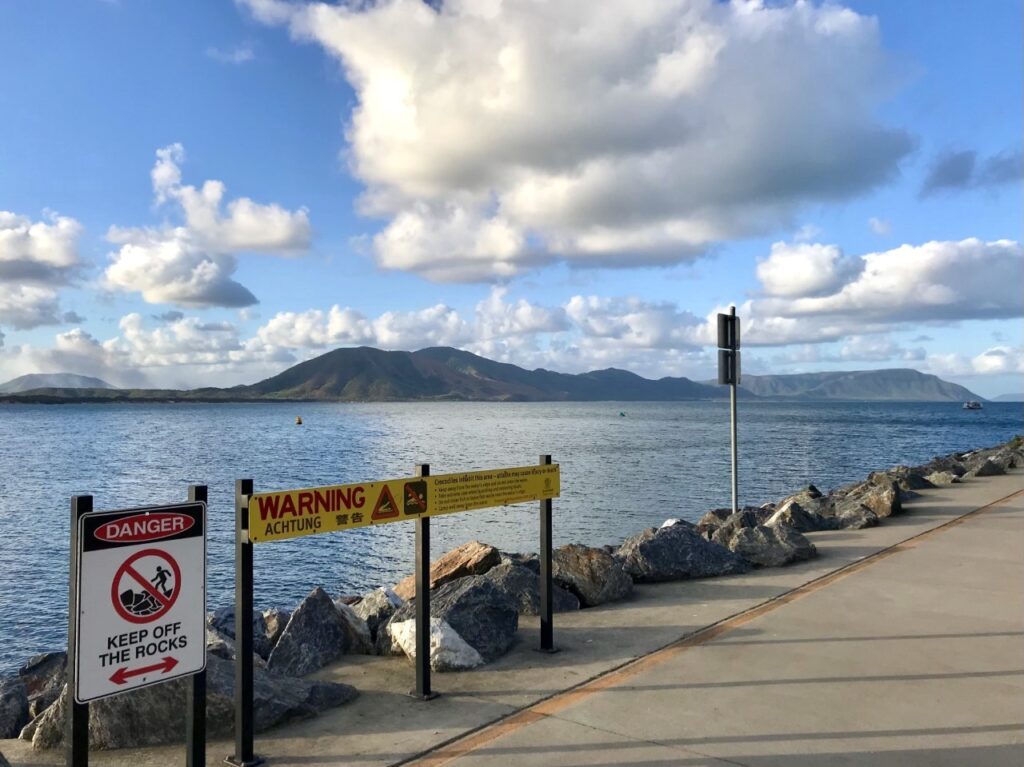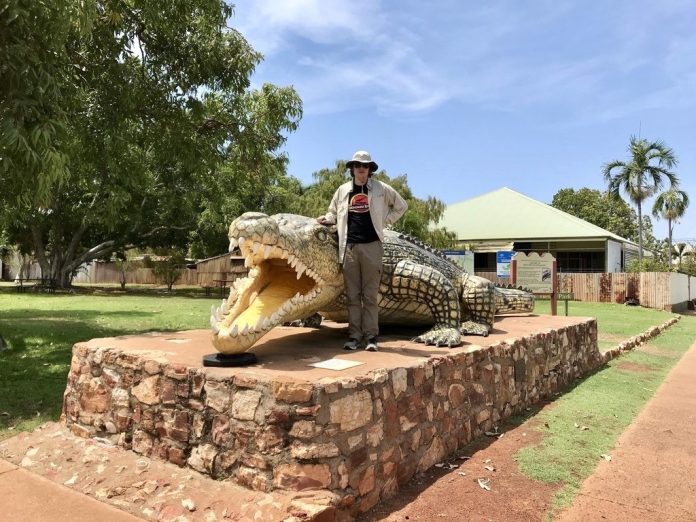There’s nothing like a climate-controlled car for forgetting what real heat feels like, even in the ten-minute drive from our motel to Chinaman Dam, on the outskirts of Cloncurry. It’s a weighted blanket of little prickly needles – like submerging your whole body in an upscaled version of one of those novelty pinboards. The incessant drone of the Cicadas hits next – not your ordinary Sydney Cicadas with their circular rhythms. These are of the northern variety, producing a slightly undulating, high-pitched wall of noise. And then it’s the sanguine red earth, stretching down all the way to the bank of a murky reservoir sitting beneath a craggy outcrop.
A steady stream of grey nomads heading southwards through Central Queensland had made me feel like a madman in my determined drive towards the gulf. Yet I’d been excited to finally get out to Cloncurry. An earlier trip in the closing days of 2020 had missed the small town in favour of Mt Isa, Boulia, and the Min Min road. My late grandmother often mentioned the town in passing producing a sepia-tinted sense that a limb of my ancestral body had rested upon the place in the amorphous late-1800s.
Just as important, however, was a simpler fact produced by the gulfward humidity of the place. Cloncurry is the first town on the Croc Country frontier: from there on up to the Gulf of Carpentaria – and onwards around the coast to Gladstone – one must stay at least five metres from the water’s edge, avoid high-risk areas at dawn, dusk and night, and dispose of fishing waste safely. Yellow “Achtung! Crocodile!” signs abound at every body of water.

Chinaman Dam was such a place. Regardless, a couple on the young side of middle-age lounged in camp chairs by an oversized caravan parked by the water’s edge. A small white dog splashed about in the shallows, sniffing at the little bits of green algae gathered along the bank. Shimmering apprehension trickled beneath my skin, pooling in my extremities and rising through my body. Scenes of crocodile-induced carnage flooded my mind, set to the soundtrack of an Attenborough documentary – specifically the part where the water buffalo nuzzles the silent water.
For a moment, even Bob Katter’s disgusting declaration in November 2017 about same-sex marriage – that he “ain’t spending any time on it, because in the meantime, every three months, a person is torn to pieces by a crocodile in North Queensland” – crossed my mind.
What on earth were these people thinking? This was your archetypal crocodile attack scene. Most of us picture hapless tourists being swiped from some remote riverbank. But is this an accurate picture?
We are submerged in a foaming torrent of crocodile-related misinformation, from the falsified statistics propagated by unstable politicians to the exaggeration of clickbait media outlets. Often, ‘stupid’ tourists are cast alongside wizened old locals who can never seem to believe the idiocy on display. In some cases these locals, usually men, are positioned as heroes. This carries across into our popular culture. The first half of Crocodile Dundee – where a rugged Paul Hogan rescues his arrogant American companion from a crocodile attack – comes to mind. With this narrative so awash throughout our media, it’s no wonder this mythology has permeated our collective mindset.
I too succumbed to this narrative. It wasn’t until after my return to subtropical Sydney, where I studied crocodiles as a part of my Science of Australia’s Deadly Animals course, that I discovered the statistics indicate a different reality. In 2017, a CSIRO review of Queensland data from 1971 onwards found that a vast majority of attack victims were adult men. More surprisingly, 77 per cent of these attacks involved locals or regular visitors to the interaction site. What’s more, these attacks overwhelmingly occur in the populated strip of coast between the Daintree and Townsville, not in the amorphous outback.
Yet even these figures can be misleading without context. An epidemic of local men mauled by marauding maritime maws is just as chilling to your average punter as the more than mildly misogynistic image of a hapless, scantily clad supermodel being sucked beneath the water, never to be seen again. It’s certainly as scary, if not more so, to politicians like the akubra-wearing loose cannon Bob Katter, judging from his franticly delivered rhetoric.
“But,” you might say, “if a person is being torn apart by a crocodile every three months surely something needs to be done?”. Perhaps a cull is required, or a return to the wholesale crocodile hunting days prior to the 1970s, when estuarine crocodiles almost went extinct. But Katter’s alarmist statistics are false: CSIRO-reviewed data included only 35 fatal incidents in 46 years. This means that in Queensland, less than one fatal attack occurs per year, despite a significantly increased crocodile population.
To make matters worse, Katter targeted crocodiles as a toothy, scary and easy-to-demonise punching bag to deflect from serious human rights issues: in this case same-sex marriage. When his constituents are scared of crocodiles and baying for blood, they are not as susceptible to his outdated views. Also, it’s likely metropolitan media will be awash with memes about how kooky Katter is with his erratic switching between subjects and eccentric North Queenslander preoccupation with crocodiles, instead of his political track record.

The ongoing presence of crocodiles in Queensland can be very beneficial. They are important apex predators that have helped regulate ecosystems for millions of years and are a key part of the tourism industry in North Queensland. In the glare, humidity, and 35°C heat of the Daintree in November, 20 tourists – including myself – clambered from the air-conditioned bus and climbed into a sweltering canvas-topped boat. We sat in the scalding sun, burning any bit of arm rested outside the roof’s shade, and keeping our eyes keenly on the green-brown water of a tributary of the Daintree river alert for beady eyes.
For an hour we listened to the bantering chatter of our enthusiastic boat captain – a nudist from the north who made friends with his local cassowary – and got excited every now and then when a stick floated past. Finally, our guide pointed at a remarkably cute little snout beneath the green boughs of the rainforest, its tangled fingers dancing across the water. For three seconds the juvenile crocodile cruised past the boat, precipitating a flurry of activity surrounding people’s pocketed iPhones and a breezy aura of silence, mixed with wonder.
A busload of people from all across the world had spent an hour in the tropical air just to glimpse a crocodile, and came away happy. Flush with cash, these people patronised a variety of local businesses selling all manner of things from crocodile burgers to crocodile shirts and crocodile-themed knick-knacks. Crocodiles, then, aren’t just important to their ecosystems, they’re important to us.
But this doesn’t mean they don’t deserve our healthy respect. Despite fatality stats that are far lower than many presume, the mortal danger posed by crocodiles in tropical Queensland is very real. It is not for nothing that at every waterway from the Gulf to Gladstone has a conspicuous yellow sign warning people to stay away from the water’s edge.
Misusing crocodiles as a political talking point to push a conservative agenda is not an example of this respect. In the end, staying Crocwise in Croc Country requires caution towards both crocodiles and the veritable waterfall of misinformation that surrounds them. So, next time you see a man in an Akubra tell you that the crocodiles need to die, contemplate your conditioning and consider this complexity.


